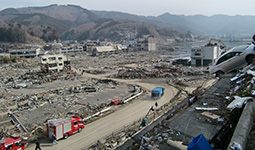Home > Highlighting JAPAN > Highlighting Japan May 2019 > Regional Revitalization
Highlighting JAPAN


Tsunami Recovery and New Town Development
Heavily damaged by the tsunami which followed the Great East Japan Earthquake of March 2011, Onagawa Town in Miyagi Prefecture has achieved safety and renewed vigor by rebuilding its urban district in a compact form.
Onagawa Town in Miyagi Prefecture is located on the Pacific coast of the Tohoku region of northeast Japan, which is characterized by its many intricate small inlets and bays. An abundance of fishery products are caught year round off Onagawa in waters close to the island of Kinkasan, one of the world’s most productive fishing grounds. Onagawa has thus developed as a port town based on the fishing and marine product processing industries.
However, the Great East Japan Earthquake that occurred on March 11, 2011 inflicted devastating damage on the town. A tsunami close to 15 meters high left 827 people dead and missing among a population of about 10,000, and destroyed almost all the buildings along the coast. Administrative functions were hamstrung and the town’s industrial foundations were almost entirely lost.
The town worked hard to recover, however, drawing for courage on a short but touching poem composed by a boy from the town immediately after the earthquake: “Onagawa was not washed away. It will be reborn into a new Onagawa. The people will never give up. To feel the joy of living in a new Onagawa.”
About two months after the earthquake, the town established the Restoration Plan Formulation Committee consisting of experts in urban planning and representatives of the chamber of commerce and women’s society. The Committee held public hearings and worked on formulating restoration plans reflecting the townspeople’s opinions. About six months after the earthquake, the town decided on the restoration plans and started building a new port town based on the basic vision of disaster reduction.
Before the earthquake, many Onagawa people lived on the limited area of flat land surrounded by mountains along the coast. To reestablish itself as a town where people can live in safety, the planners cut into the mountains, developed residential areas, raised the embankment of the flat land with the cut soil, concentrated educational, medical, transport, commercial and administrative centers around Onagawa Station and the port of Onagawa, and reconstructed a compact central urban district. The intention was to reproduce a town that could continue to create liveliness, even amid the acceleration of depopulation, by concentrating the flows of people from residential areas to a central urban district.
JR Onagawa Station reopened in March 2015, four years after the earthquake. The new station building, featuring a white roof based on an image of a black-tailed gull in flight, was designed by world-famous architect Shigeru Ban. Inside the station building is the hot spring facility Onagawa Onsen Yupo’po. The wall of the bathhouse is decorated with a beautiful tile painting by Hiroshi Senju, a renowned Japanese painter. An observation deck on the third floor affords a view of Onagawa Town and Onagawa Bay. Onagawa Station made a new start as the gateway to the town.
In addition, in December 2015, Seapal-Pier Onagawa, a commercial facility based on the concept of “a town with a park from which people can enjoy seeing the sea,” opened along a brick promenade linking Onagawa Station and the port of Onagawa. This facility is managed and operated by a town development company that was established by a partnership between the public and private sectors, such as Onagawa Town and its chamber of commerce. Seapal-Pier Onagawa is not only a place where people both inside and outside the town can gather to enjoy the landscape surrounded by mountains and the sea, but is also designed in a way that enables it to work as an evacuation route along which the brick road leads to high ground in case of disaster.
Hideki Doi, an official from the Industrial Promotion Division of Onagawa Town, says, “Inside the facility, not only did business recommence after the earthquake, but new businesspeople from both inside and outside the town also established about thirty shops such as restaurants, souvenir shops and daily commodities shops. This makes the place more lively than it was before the earthquake, attracting many tourists as well as local residents.”
As the new townscape is being developed, a memorial monument was built, structural remnants that remained after the earthquake were preserved and the younger generations took action to convey the memory of the earthquake to future generations. In February 2013, students from Onagawa Junior High School played a central role in launching the Onagawa Inochinosekihi project of building stone monuments with lessons from the earthquake inscribed on them at all twenty-one beaches in the town. Seventeen monuments have been built to date by donations collected under the slogan of “Protecting lives 1,000 years on.” The boy who composed the inspirational poem became an official in the Onagawa Town government in 2018 after graduating from high school and joined the members who would work to restore the town and create a new Onagawa.
Onagawa Town is being reborn into a new town full of vigor, without forgetting the earthquake.
© 2009 Cabinet Office, Government of Japan








